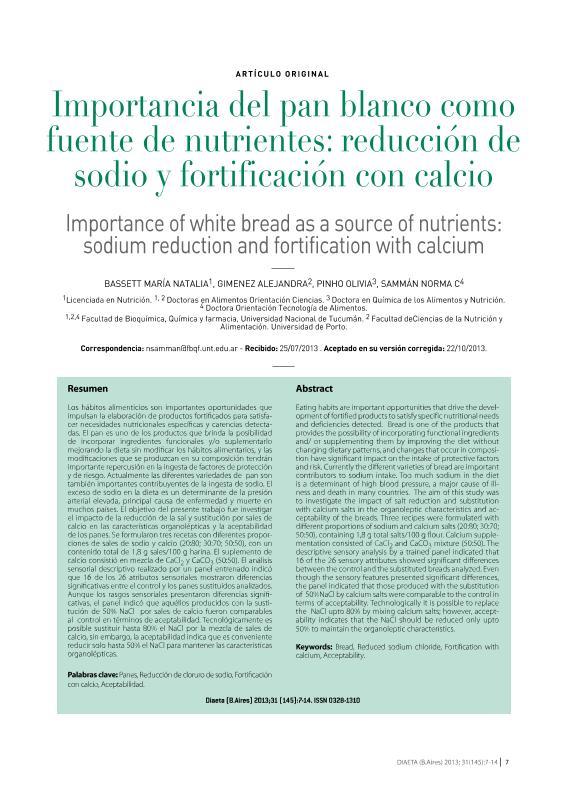Artículo
Los hábitos alimenticios son importantes oportunidades que impulsan la elaboración de productos fortificados para satisfacer necesidades nutricionales específicas y carencias detectadas. El pan es uno de los productos que brinda la posibilidad de incorporar ingredientes funcionales y/o suplementarlo mejorando la dieta sin modificar los hábitos alimentarios, y las modificaciones que se produzcan en su composición tendrán importante repercusión en la ingesta de factores de protección y de riesgo. Actualmente las diferentes variedades de pan son también importantes contribuyentes de la ingesta de sodio. El exceso de sodio en la dieta es un determinante de la presión arterial elevada, principal causa de enfermedad y muerte en muchos países. El objetivo del presente trabajo fue investigar el impacto de la reducción de la sal y sustitución por sales de calcio en las características organolépticas y la aceptabilidad de los panes. Se formularon tres recetas con diferentes proporciones de sales de sodio y calcio (20:80; 30:70; 50:50), con un contenido total de 1,8 g sales/100 g harina. El suplemento de calcio consistió en mezcla de CaCl2 y CaCO3 (50:50). El análisis sensorial descriptivo realizado por un panel entrenado indicó que 16 de los 26 atributos sensoriales mostraron diferencias significativas entre el control y los panes sustituidos analizados. Aunque los rasgos sensoriales presentaron diferencias significativas, el panel indicó que aquéllos producidos con la sustitución de 50% NaCl por sales de calcio fueron comparables al control en términos de aceptabilidad. Tecnológicamente es posible sustituir hasta 80% el NaCl por la mezcla de sales de calcio, sin embargo, la aceptabilidad indica que es conveniente reducir solo hasta 50% el NaCl para mantener las características organolépticas. Eating habits are important opportunities that drive the development of fortified products to satisfy specific nutritional needs and deficiencies detected. Bread is one of the products that provides the possibility of incorporating functional ingredients and/ or supplementing them by improving the diet without changing dietary patterns, and changes that occur in composition have significant impact on the intake of protective factors and risk. Currently the different varieties of bread are important contributors to sodium intake. Too much sodium in the diet is a determinant of high blood pressure, a major cause of illness and death in many countries. The aim of this study was to investigate the impact of salt reduction and substitution with calcium salts in the organoleptic characteristics and acceptability of the breads. Three recipes were formulated with different proportions of sodium and calcium salts (20:80; 30:70; 50:50), containing 1,8 g total salts/100 g flour. Calcium supplementation consisted of CaCl2 and CaCO3 mixture (50:50). The descriptive sensory analysis by a trained panel indicated that 16 of the 26 sensory attributes showed significant differences between the control and the substituted breads analyzed. Even though the sensory features presented significant differences, the panel indicated that those produced with the substitution of 50%NaCl by calcium salts were comparable to the control in terms of acceptability. Technologically it is possible to replace the NaCl upto 80% by mixing calcium salts; however, acceptability indicates that the NaCl should be reduced only upto 50% to maintain the organoleptic characteristics.
Importancia del pan blanco como fuente de nutrientes: reducción de sodio y fortificación con calcio
Título:
Importance of white bread as a source of nutrients: sodium reduction and fortification with calcium
Fecha de publicación:
2013
Editorial:
Asociación Argentina de Dietistas y Nutricionistas Dietistas
Revista:
Diaeta
ISSN:
0328-1310
e-ISSN:
1852-7337
Idioma:
Español
Tipo de recurso:
Artículo publicado
Clasificación temática:
Resumen
Archivos asociados
Licencia
Identificadores
Colecciones
Articulos(INSIBIO)
Articulos de INST.SUP.DE INVEST.BIOLOGICAS
Articulos de INST.SUP.DE INVEST.BIOLOGICAS
Citación
Bassett, Maria Natalia; Giménez, María Alejandra; Pinho, Olivia; Samman, Norma Cristina; Importancia del pan blanco como fuente de nutrientes: reducción de sodio y fortificación con calcio; Asociación Argentina de Dietistas y Nutricionistas Dietistas; Diaeta; 31; 145; -1-2013; 7-14
Compartir




